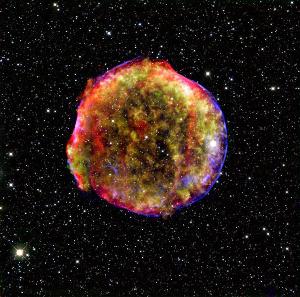Post
Stella Nova
4 December 2012
In November of 1572 Wolfgang Schuler observed a new star in the constellation of Cassiopeia. A few days later it was observed by Tycho Brahe, who began taking careful observations of this visiting star, which came to be known as Tycho’s supernova. By the time Tycho observed the star, it was about as bright as Jupiter. Eventually it reached a brightness rivaling Venus before gradually fading from view over the next year and a half.
The appearance of this new star, or stella nova as it what known in Latin, was a major discovery. The prevailing view at the time was that the stars were fixed and unchanging. Planets wander through the sky and comets appear from time to time, but the stars were eternal. Tycho’s observations demonstrated this was not the case, and it spurred a new interest in making accurate measurements of the heavens.
 Chandra/Harvard
Chandra/HarvardThe remnant of this supernova wasn’t discovered until the middle of the last century, first by radio telescopes in the 1950s, then optically in the 1960s. Since then it has been studied in great detail, and you can see a modern composite image. We now know it was a type Ia supernova about 8000 to 9000 light years away.
About 30 years later, in 1604, Kepler observed a supernova in the constellation of Ophiuchus. Since then there hasn’t been an observed supernova in our galaxy, which is unfortunate and a little perplexing. Studies indicate that a galaxy of our size and type should have a supernova about once every 50 years. That we haven’t seen another in 400 years seems to indicate that there’s a crucial aspect of supernova physics we don’t understand, or astronomers are having a 400 year long streak of bad luck.